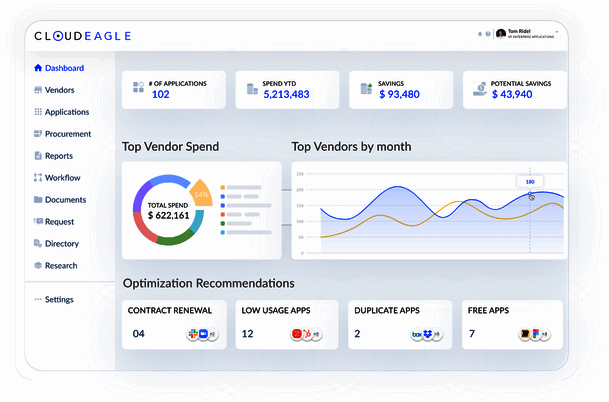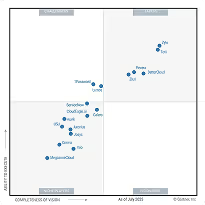HIPAA Compliance Checklist for 2025

Procurement is no longer a back-office function, it’s a strategic process that drives efficiency, savings, and resilience across the organization. Whether sourcing office supplies, enterprise software, or large-scale infrastructure, following a structured procurement process ensures every purchase aligns with business goals and delivers measurable ROI.
This guide breaks down the stages of the procurement process, from identifying needs to final negotiations, helping your team streamline workflows, strengthen vendor relationships, and enhance cost control.
TL;DR
- Procurement has evolved into a strategic function driving savings, efficiency, and business resilience.
- A structured procurement process ensures every purchase aligns with organizational goals and ROI.
- Automation and data visibility eliminate manual errors, cut cycle times, and enhance vendor collaboration.
- AI-powered platforms like CloudEagle.ai enable real-time spend tracking, benchmarking, and smarter negotiations.
- End-to-end procurement automation can save up to 30% in SaaS spend and reduce workload by 50%.
1. What Is the Procurement Process?
The procurement process is the end-to-end system a business uses to acquire goods and services, from identifying a need to paying the Vendor. It involves several steps, including planning, sourcing and evaluating Vendors, negotiating terms, creating purchase orders, receiving and inspecting goods, and finally processing invoices and payments.
Definition and Purpose
The procurement process is the structured workflow that organizations follow to source, acquire, and manage goods or services efficiently. It involves a series of defined steps from identifying needs and evaluating Vendors to negotiating contracts and managing vendor performance.
Procurement isn’t just about purchasing; it’s about strategic sourcing that ensures the right products and services are obtained at the right price, time, and quality level.
Why It Matters for Business Efficiency
A clear procurement process helps businesses:
- Eliminate inefficiencies caused by manual purchasing.
- Maintain cost control and prevent budget overruns.
- Improve vendor relationships and transparency.
- Strengthen compliance and reduce risk.
- Increase overall operational agility.
Companies with mature procurement strategies report 15–20% savings on total spend and faster purchasing cycles through automation and process optimization.
2. Key Stages of the Procurement Process
A. Identifying Business Needs
Every procurement cycle begins with a clear understanding of what the business requires, whether that’s new software, raw materials, or professional services.
This stage involves:
- Gathering input from departments or project leads.
- Understanding budget availability.
- Aligning requests with business priorities.
Proper need identification prevents overspending and ensures every purchase contributes directly to strategic objectives.
B. Specification Development
Once the need is identified, procurement teams define the product or service specifications. This may include:
- Technical and functional requirements.
- Quality and performance standards.
- Delivery timelines and service-level expectations.
Clear specifications help vendors deliver accurate quotes and reduce confusion during negotiations.
C. Vendor Research and Shortlisting
Next, the team researches potential Vendors that can meet the defined specifications. Vendor evaluation typically considers:
- Price competitiveness.
- Industry reputation.
- Compliance with certifications and regulations.
- Reliability and capacity to deliver.
Shortlisting 3–5 Vendors allows for fair comparison while maintaining focus on quality and reliability.
D. Request for Proposal (RFP) or Quotation (RFQ)
At this stage, the procurement team issues formal requests to shortlisted vendors.
- RFP (Request for Proposal): Used for complex purchases that require customized solutions.
- RFQ (Request for Quotation): Used when price is the primary factor and product requirements are clear.
The goal is to collect comprehensive information about pricing, delivery timelines, and vendor capabilities.
E. Bid Evaluation and Vendor Selection
Procurement professionals analyze vendor responses based on weighted criteria such as:
- Total cost of ownership.
- Product quality and service support.
- Contract flexibility.
- Vendor track record.
Cross-functional teams, including finance and operations, often collaborate to ensure the selected Vendor meets technical, financial, and compliance expectations.
F. Contract Negotiation and Award
After selecting the preferred Vendor, the focus shifts to negotiation. This step ensures that all terms - pricing, Service Level Agreements, data security, and delivery commitments are optimized for mutual benefit.
Effective negotiation can lead to:
- Better pricing and payment terms.
- Risk mitigation through well-defined clauses.
- Stronger long-term vendor partnerships.
Once finalized, both parties sign the contract, formalizing the relationship.
G. Order Fulfillment and Receipt
After the contract is awarded, the Vendor delivers the goods or services. Procurement teams verify that all items meet agreed-upon specifications and quality standards before approving payment.
This stage includes:
- Purchase order confirmation.
- Goods receipt verification.
- Quality inspection and acceptance.
Accurate documentation ensures compliance and supports future audits.
3. What Happens After Procurement? Ensuring Long-Term SaaS Value and Compliance
A. Vendor Relationship Management (SRM)
Procurement doesn’t end with a signed contract. Ongoing relationship management ensures long-term performance and value.
SRM focuses on:
- Monitoring Vendor performance.
- Addressing issues proactively.
- Building collaborative, transparent partnerships.
B. Invoice Matching and Payment
Procurement and finance teams verify that invoices match purchase orders and delivery receipts, a process known as three-way matching.
This prevents payment errors and supports accurate financial reporting.
C. Performance Review and Feedback Loop
Post-purchase evaluations measure vendor reliability and contract adherence. Data from these reviews informs future sourcing decisions and helps optimize the procurement cycle.
4. Common Challenges in Procurement Workflows
A. Manual Errors and Delays
Relying on spreadsheets and emails increases the risk of data entry errors, missed renewals, and delayed approvals.
B. Poor Vendor Visibility
Without centralized Vendor data, organizations struggle to track vendor performance, leading to inconsistent quality and missed savings opportunities.
C. Lack of Spend Control and Compliance
Unmanaged purchases (or “shadow procurement”) lead to budget overruns and compliance gaps. Limited visibility into expenses makes it difficult to enforce purchasing policies.
5. How Procurement Tools Can Streamline the Process
A. Automating Repetitive Tasks
Modern procurement solutions automate manual steps such as purchase requests, approvals, and renewals. Automation eliminates errors and reduces cycle times by up to 60%.
B. Tracking Procurement in Real Time
Procurement platforms offer real-time dashboards for spend visibility, budget tracking, and Vendor performance metrics, helping teams make faster, data-driven decisions.
C. Enhancing Vendor Collaboration
Cloud-based solutions enable direct communication and document sharing between buyers and Vendors. This transparency strengthens relationships and improves accountability across the supply chain.
6. How CloudEagle.ai Optimizes Your End-to-End SaaS Procurement Process
Modern procurement teams are under immense pressure to manage a fast-growing SaaS portfolio, tracking hundreds of vendors, navigating renewals, and ensuring every purchase aligns with compliance and budget goals.
Yet, manual spreadsheets, scattered approvals, and inconsistent vendor data still dominate the process.
CloudEagle.ai changes that.
It’s an AI-powered, end-to-end SaaS procurement platform built to simplify every stage of the procurement lifecycle from need identification to negotiation and renewal management, all in one unified workspace.
Here’s how CloudEagle.ai transforms the SaaS procurement process from reactive to intelligent:
A. Centralized SaaS Discovery & Visibility
Most organizations underestimate how many SaaS tools they actually use. CloudEagle.ai automatically discovers all applications across your enterprise, including shadow IT and unmanaged tools, by integrating with expense systems, SSO platforms, and finance data.

What you get:
- A single dashboard showing every active and inactive SaaS tool.
- Visibility into app usage, ownership, and renewal dates.
- Early detection of redundant or unused apps to reduce waste.
✅ Result: Teams gain full control over their SaaS ecosystem and eliminate hidden costs before they grow.
B. Automated Purchase & Renewal Workflows
Procurement shouldn’t mean chasing approvals or tracking down contract PDFs. CloudEagle.ai’s no-code workflow automation makes it effortless to standardize and speed up every request from new purchases to renewals.

Capabilities include:
- Configurable approval chains for finance, IT, and compliance teams.
- Automated renewal alerts and vendor reminders.
- Centralized document storage for quotes, invoices, and contracts.
✅ Result: Seamless collaboration across teams and 50% faster procurement cycles.
C. AI-Powered Vendor Intelligence & Benchmarking
Knowing what to pay and how to negotiate shouldn’t be a guessing game. CloudEagle.ai’s AI-driven vendor intelligence engine pulls data from thousands of deals to provide real-time price benchmarks, vendor performance insights, and compliance ratings.

You can:
- Compare pricing with market averages.
- Evaluate vendors based on real contract data.
- Identify negotiation opportunities backed by actual benchmarks.
✅ Result: Data-backed confidence in every negotiation, typically reducing costs by 15–30%.
D. Assisted & Outsourced Procurement Services
When bandwidth is limited, CloudEagle.ai’s expert sourcing team steps in. Our specialists manage negotiations, contract renewals, and vendor communications on your behalf, leveraging market insights to get you the best possible deal.
They handle:
- Renewal negotiations and pricing discussions.
- Vendor evaluation and selection.
- End-to-end management of procurement timelines.
✅ Result: Procurement teams save hundreds of hours annually while securing enterprise-grade contracts at optimized rates.
E. Real-Time Spend Tracking & Optimization
Visibility doesn’t stop at purchase.CloudEagle.ai continuously monitors usage, license utilization, and renewal timelines across all your tools. Its intuitive dashboards highlight opportunities for consolidation, right-sizing, and cost recovery.
You’ll see:
- Active vs. inactive license data.
- Upcoming renewals with recommended actions.
- Total spend by department, category, or vendor.
✅ Result: Continuous optimization and predictable SaaS budgeting across your organization.
The Business Impact
By automating the entire procurement lifecycle, CloudEagle.ai eliminates manual effort, strengthens governance, and empowers finance, IT, and procurement teams to work together strategically.
On average, CloudEagle.ai customers achieve:
- 💰 15–30% savings in annual SaaS spend.
- ⏱️ 50% reduction in procurement workload.
- 🔒 100% visibility into vendor renewals, risk, and compliance.
CloudEagle.ai isn’t just a procurement tool, it’s the intelligent command center for your entire SaaS lifecycle.
From discovery to negotiation, it turns complexity into clarity and delivers measurable business impact.
👉 Ready to optimize your procurement process? Book a personalized demo with CloudEagle.ai today.
6. Conclusion
A well-structured procurement process ensures that every purchase from raw materials to SaaS subscriptions is strategic, compliant, and cost-effective. By moving from manual workflows to automated procurement systems, enterprises can accelerate approvals, gain spend visibility, and build stronger Vendor partnerships.
Whether you’re optimizing traditional sourcing or managing complex SaaS environments, platforms like CloudEagle.ai enable true end-to-end procurement efficiency from need identification to negotiation and beyond.
CTA - Streamline your procurement journey with CloudEagle.ai, start optimizing your spend now.”
Frequently Asked Questions
1. What are the main stages of the procurement process?
The seven stages include identifying needs, defining specifications, researching Vendors, issuing RFPs/RFQs, evaluating bids, negotiating contracts, and managing fulfillment, ensuring transparency, cost control, and efficiency.
2. What is the difference between the procurement process and the procurement lifecycle?
The procurement process covers individual purchasing steps, while the procurement lifecycle spans the full journey from planning and sourcing to Vendor performance review, ensuring continuous improvement and long-term value
3. How do modern procurement solutions optimize the end-to-end process?
Tools like CloudEagle.ai automate workflows, centralize Vendor data, and deliver AI insights for negotiation and spend analysis reducing manual effort, accelerating cycle times, and improving compliance and savings.
4. What are the key challenges in traditional procurement workflows?
Manual errors, lack of Vendor visibility, missed renewals, and weak spend control slow operations. CloudEagle.ai solves these with automation, unified dashboards, and real-time insights across all procurement activities.
5. How can CloudEagle.ai enhance SaaS procurement efficiency?
CloudEagle.ai discovers all SaaS tools, automates renewals, benchmarks vendor pricing, and offers AI-backed negotiation support, helping enterprises cut SaaS spend by 15–30% and speed procurement cycles by 50%.

%201.svg)








.avif)




.avif)
.avif)




.png)









